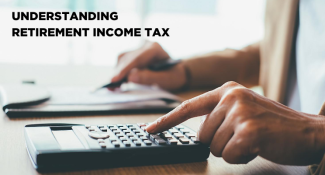
Understanding Retirement Income Tax
Understanding Retirement Income Tax
When you retire, you’ll likely draw your income from several sources—such as retirement accounts, taxable investment accounts, and Social Security Benefits. Each of these sources is taxed according to its own rules. So, in order to accurately plan for your retirement, you need to know what these rules are, whether (and when) you’re required to make withdrawals, and how paying taxes on distributions will impact your overall financial goals.
Here’s a breakdown of the most commons sources of retirement income and how they’re taxed:
Traditional IRA and traditional 401(k)
Withdrawals from traditional tax-deferred retirement accounts are taxed at your normal income tax rate. Once you reach a certain age, you must start taking—and paying taxes on—required minimum distributions (RMDs). The IRS changed RMD rules in 2020.[1] If you reached age 70½ in 2019, you should have taken your first RMD by April 1, 2020. If you reached age 70½ in 2020 or later, you are required to take your first RMD by April 1 of the year following the year you turn 72.
Roth IRAs
Because contributions to Roth IRAs are made with after-tax money, withdrawals from these accounts are tax-free. You can withdraw contributions to your Roth account at any age; however, withdrawals on earnings before age 59 ½ are subject to early withdrawal penalties. Roth IRAs do not have RMDs like traditional IRAs, so your money can continue growing in the account. Because withdrawals from Roth IRAs are tax-free, consider making withdrawals from this account last to allow your savings to benefit from tax-free growth for as long as possible.
Taxable investments
Profits from the sale of stocks, bonds, and other investments outside of tax-advantaged retirement accounts are taxed at capital gains rates, which vary depending on how long you’ve owned the investments. Short-term capital gains are taxed as ordinary income and apply to investments you’ve owned for one year or less. Long-term investments, those held for more than a year before selling, are subject to preferential long-term capital gains rates of 0%, 15%, or 20%, depending on your tax bracket.[2]
Social Security
The tax rate for Social Security benefits depends on your provisional income, which is the sum of your adjusted gross income, tax-free interest from other investments, and 50 percent of your Social Security benefits. You’ll have to pay taxes if your provisional income exceeds $25,000 on an individual tax return or $32,000 on a joint return. Only up to 85% of your Social Security Benefits are subject to tax.[3]
Annuities
You typically purchase an annuity with after-tax income. The annuity then pays out income over time. The portion of the payment representing your principal is tax-free, and you’ll pay taxes on any earnings. If you purchased the annuity with pretax funds, such as from a traditional IRA, your entire payment would be taxed as ordinary income.
Making a withdrawal plan
Once you understand how your retirement income is taxed, you can make a tax-efficient plan to support you in your retirement years. You might consider a plan that looks like the following:
- Taking withdrawals from traditional IRA and traditional 401(k) accounts first to satisfy annual RMDs.
- Next, take withdrawals from taxable accounts.
- Take withdrawals from Roth IRAs, and Roth 401(k) accounts last. The longer you can avoid drawing down these plans, which aren’t subject to RMDs, the longer they can benefit from tax-free growth.
A careful withdrawal plan—and keeping your money in tax-exempt accounts as long as possible—can help you maximize your investment returns while minimizing the taxes you’ll owe.
[1] Source: Internal Revenue Service: https://www.irs.gov/retirement-plans/plan-participant-employee/retirement-topics-required-minimum-distributions-rmds
[2] Source: Internal Revenue Service: https://www.irs.gov/taxtopics/tc409
[3] Source: Social Security Administration: https://www.ssa.gov/benefits/retirement/planner/taxes.html

